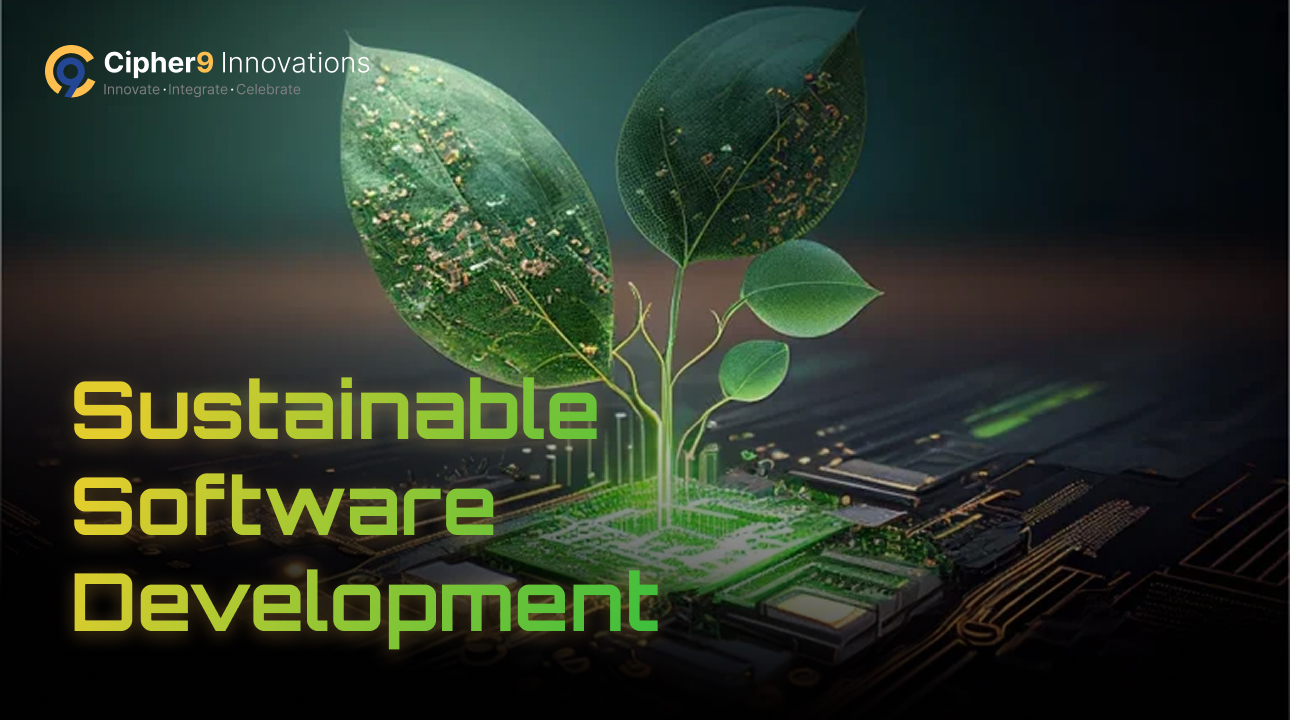
Introduction
Digital transformation is often praised for driving innovation, efficiency, and scalability. However, its environmental impact receives far less attention. As industries rely more on data centers, cloud platforms, and high-performance applications, the energy footprint of software continues to rise.
At Cipher9 Innovations, we believe the future of digital growth must also embrace sustainability. The goal should not only be to build scalable applications but also to design systems that are efficient, environmentally responsible, and resilient. When businesses rethink how they design, develop, and deploy applications, they can lower costs, extend product lifecycles, and reduce carbon footprints—all while staying competitive.
In this blog, we explore the environmental cost of software, the core principles of green software engineering, the role of programming languages, and the business benefits of adopting sustainable practices.
How Software Impacts the Environment
The demand for digital services has sharply increased, which in turn has fueled higher energy consumption worldwide. Data centers and cloud infrastructures consume enormous amounts of electricity, much of it generated from non-renewable sources. As a result, software indirectly contributes to rising greenhouse gas emissions.
While many organizations focus on speed and scalability, the hidden environmental costs are often ignored. For example, idle computations, background processes, and redundant data requests all leave behind a carbon trail.
At Cipher9 Innovations, we encourage energy-conscious development strategies such as optimized coding, green hosting, and reduced redundancy. Not only do these approaches cut emissions, but they also reduce costs and extend hardware lifespans, while ensuring compliance with emerging green technology regulations.
Core Principles of Green Software Engineering
Sustainable or green software engineering ensures that digital systems minimize environmental harm without losing performance. At Cipher9 Innovations, we embed these guiding principles into every solution we design:
- Energy Efficiency – Optimized code lowers CPU and memory use, cutting down electricity consumption at scale.
- Carbon Awareness – Running workloads during cleaner energy hours or using renewable-powered data centers reduces emissions.
- Hardware Longevity – Efficient software helps devices last longer, reducing e-waste and costly upgrades.
- Optimized Resource Usage – Compression, caching, and data minimization lower bandwidth and storage needs.
- Lifecycle Planning – Sustainability should be considered from design through deployment and eventual decommissioning.
- Smart Scaling – Autoscaling, serverless computing, and containerization prevent wasted resources from over-provisioning.
By following these principles, businesses can create applications that are both technologically advanced and climate-conscious.
Programming Languages and Energy Efficiency
Programming languages are not only tools for functionality—they also influence a system’s energy usage.
- Low-level languages such as C, C++, and Rust are compiled into machine code, making them fast and energy-efficient. They work best for high-performance systems like AI, IoT, and embedded applications.
- High-level languages like Python, Java, and JavaScript are easier to use but demand more memory and processing power.
At Cipher9 Innovations, we carefully balance developer productivity with runtime efficiency. For instance, Python may be perfect for rapid prototyping, but for large-scale deployments, Rust or Go might deliver a more sustainable performance.
Choosing the right language at the right time is therefore critical for reducing software’s environmental impact.
Eco-Friendly Software Architecture
Architecture defines how a system scales, communicates, and consumes resources. A sustainable software architecture helps minimize energy use across infrastructures.
- Microservices – Scale components independently, preventing wasted resources.
- Serverless Computing – Execute code only when needed, saving energy.
- Containerization – Use lightweight containers instead of full virtual machines to improve efficiency.
- Green Cloud Providers – Choose platforms powered by renewable energy.
- Smart Resource Scheduling – Run intensive tasks during high renewable availability.
By embedding these strategies into system design, organizations can ensure scalable, efficient, and environmentally responsible architectures.
Business Advantages of Sustainable Software
Adopting sustainable software development offers more than environmental benefits—it also creates clear business value:
- Cost Optimization – Lower compute, storage, and hosting expenses.
- Brand Trust – Customers increasingly prefer eco-conscious companies.
- Regulatory Compliance – Stay ahead of climate-related policies and avoid last-minute changes.
- Extended Device Reach – Lightweight apps run smoothly even on older devices.
- Talent Attraction – Purpose-driven companies attract top developers.
- Competitive Edge – Sustainability becomes a unique market differentiator.
At Cipher9 Innovations, we transform sustainability into both an ethical commitment and a growth strategy.
Partnering with Cipher9 Innovations for Sustainable Software
Sustainability requires vision and execution. Cipher9 Innovations supports organizations in embedding eco-friendly practices at every stage of the development lifecycle. Our expertise covers:
- Energy-aware architecture design
- Performance-optimized coding practices
- Sustainable cloud strategies
- Lifecycle-focused development roadmaps
With these solutions, we help enterprises build future-proof systems that cut carbon footprints while maintaining performance and scalability.
Conclusion
The era of Sustainable Software Development is here—and it is no longer optional. As the digital ecosystem expands, businesses must balance innovation with environmental responsibility.
At Cipher9 Innovations, we believe that digital transformation should be both powerful and sustainable. By weaving green principles into every stage of development, we empower organizations to achieve long-term growth while protecting the planet.
👉 The digital future does not have to come at the Earth’s expense. Together, let’s build software that lasts—responsibly, intelligently, and sustainably.

